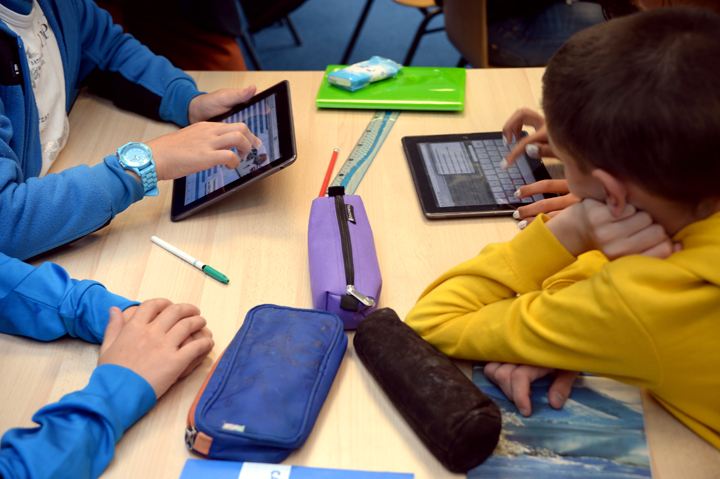TORONTO – We know the average Canadian kid (and adult, for that matter) spends too much time in front of screens – upwards of five to eight hours a day, by some estimates.

And we know the hours spent staring at screens far exceeds the recommended limits of two hours for kids under 18 and zero (yes, zero) for kids under two years old.
But when kids go back to school, trading soccer balls and paddleboards for homework and studying (that’s what they’re up late at night doing, right?), it’s tough for parents to stay on top of their child’s screen time.
Why we need screen time limits
“Screen time” includes time spent looking at smartphones, tablets, computers and televisions.
According to the Public Health Agency of Canada, an increase in sedentary screen time is one of the factors contributing to childhood obesity (along with unhealthy food choices, increased food availability and larger portion sizes).
Too much screen time can lead to poor eating habits, obesity, sleep loss, social isolation and behavioural problems, psychiatrist Dr. Shimi Kang told Global News.
But much of the modern high school student’s homework is on a computer, whether using a word processor to write an essay or the Internet for research.
Add to that time spent playing video games, watching TV and on social media, and concerned parents can be hard-pressed to keep a lid on their children’s screen time.
“The accessibility of devices is at an unprecedented level – and it’s caught parents off guard,” Kang said.
How to balance school demands and screen time limits
Matthew Johnson, director of education at MediaSmarts, said that in most cases when parents set screen time limits for their kids, they make an exception for doing school work.
But health-based screen guidelines don’t distinguish “school” time from “recreational” time.
“A screen is a screen,” Johnson said. “Even if you’re using it for good reason, it does count as time when you’re not being active.”
Johnson recommends, particularly for teenagers, that rather than setting limits parents encourage kids to use screen media in a thoughtful way, “so they are conscious of what they’re doing, so it’s not something that they just turn on without thinking about it.”
One strategy is to set times of the day or days of the week where the family simply doesn’t use screen media.
“In some ways that absence (rather than counting up towards however many hours you’re allowed) can be more meaningful in terms of using your time mindfully,” he said.
Another tip is to get children to keep a media diary. In it they can record all of the media they use, perhaps for a day or a week, depending on their age.
The idea isn’t to shame them, Johnson said, but rather to make them aware of their habits. “Because we’re not always the best authorities on our own habits – they tend to be things we do unconsciously.”
Keeping a diary can also make children think about what else they could be doing in that time spent in front of a screen.
Set an example
Parents who want to reduce their kids’ screen time might want to take a look at how much time they spend on their own devices.
Exercises like designating screen-free time and keeping a media diary shouldn’t be limited to just the kids – especially teenagers who can be particularly sensitive to adult hypocrisy. “It’s something the whole family can do,” Johnson said.
Recent data from the U.K. showed kids are worried about how many hours of screen time their parents rack up, with 25 per cent saying mom and dad had a double standard when it came to limiting screen time.
A Google poll earlier this year showed the average Canadian smartphone owner admits to spending nearly eight hours a day staring at a screen – not including the time in front of a computer at work.
“As parents we have to be very mindful about the example that we’re setting for kids,” Johnson said. “It’s very difficult to set any kind of limits or provide guidance on screen use if we’re not modelling good behaviours ourselves.”
One of the reasons such strict screen time recommendations are placed on young kids is because they are still growing and developing. Those issues are less of a concern for adults. But any time spent in front of the screen tends to come at the expense of being active, Johnson said.
Screen time also limits how much time a parent spends interacting with their family in person.
Using apps to control screen time
There are a number of mobile apps available for parents wanting to control the amount of time their child spends on devices. The apps allow parents to limit the content kids access as well as hours of use.
However Johnson believes these apps are more appropriate for younger kids.
“With older kids, once you get to around 11 or 12 and into the teens, anything you do to try and control their online experience directly is just going to be perceived as a challenge,” he said. “Rather than affecting their behaviour, it’s just going to drive them to find ways to get around it.”
Rather than force a device-blocking app on your teen, introduce them to apps that let them voluntarily disconnect. Teach them about these tools that they could use, say, if they are studying for an exam and don’t want to get distracted, recommends Johnson.
“With teenagers, setting rules really is more of a negotiation and explanation than it is setting down the law,” he said.
With a file from Global News’ Nicole Bogart




Comments